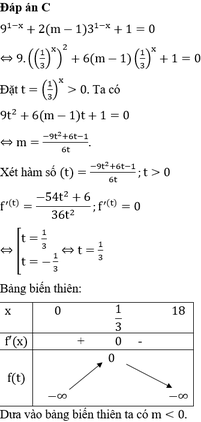Tìm tập các giá trị của m sao cho phương trình \(m\sqrt{x^2+2}=x+m\) có 2 nghiệm phân biệt.
Hãy nhập câu hỏi của bạn vào đây, nếu là tài khoản VIP, bạn sẽ được ưu tiên trả lời.


1.
Đặt \(\sqrt{x^2-4x+5}=t\ge1\Rightarrow x^2-4x=t^2-5\)
Pt trở thành:
\(4t=t^2-5+2m-1\)
\(\Leftrightarrow t^2-4t+2m-6=0\) (1)
Pt đã cho có 4 nghiệm pb khi và chỉ khi (1) có 2 nghiệm pb đều lớn hơn 1
\(\Leftrightarrow\left\{{}\begin{matrix}\Delta'=4-\left(2m-6\right)>0\\\left(t_1-1\right)\left(t_2-1\right)>0\\\dfrac{t_1+t_2}{2}>1\\\end{matrix}\right.\)
\(\Leftrightarrow\left\{{}\begin{matrix}10-2m>0\\t_1t_2-\left(t_1+t_1\right)+1>0\\t_1+t_2>2\end{matrix}\right.\)
\(\Leftrightarrow\left\{{}\begin{matrix}m< 5\\2m-6-4+1>0\\4>2\end{matrix}\right.\) \(\Leftrightarrow\dfrac{9}{2}< m< 5\)
2.
Để pt đã cho có 2 nghiệm:
\(\Leftrightarrow\left\{{}\begin{matrix}m\ne3\\\Delta'=1+4\left(m-3\right)\ge0\end{matrix}\right.\)
\(\Leftrightarrow\left\{{}\begin{matrix}m\ne3\\m\ge\dfrac{11}{4}\end{matrix}\right.\)
Khi đó:
\(x_1^2+x_2^2=4\Leftrightarrow\left(x_1+x_2\right)^2-2x_1x_2=4\)
\(\Leftrightarrow\dfrac{4}{\left(m-3\right)^2}+\dfrac{8}{m-3}=4\)
\(\Leftrightarrow\dfrac{1}{\left(m-3\right)^2}+\dfrac{2}{m-3}-1=0\)
\(\Leftrightarrow\left[{}\begin{matrix}\dfrac{1}{m-3}=-1-\sqrt{2}\\\dfrac{1}{m-3}=-1+\sqrt{2}\end{matrix}\right.\)
\(\Leftrightarrow\left[{}\begin{matrix}m=4-\sqrt{2}< \dfrac{11}{4}\left(loại\right)\\m=4+\sqrt{2}\end{matrix}\right.\)

pt. 2 mghiemej pb
`<=>Delta>0`
`<=>(m+2)^2-4(3m-6)>0`
`<=>m^2+4m+4-12m+24>0`
`<=>m^2-8m+28>0`
`<=>(m-4)^2+8>0` luôn đúng
Áp dụng vi-ét ta có:`x_1+x_2=m+2,x_1.x_2=-3m-6`
`đk:x_1,x_2>=0=>x_1+x_2,x_1.x_2>=0`
`=>m+2>=0,3m-6>=0`
`<=>m>=2`
`pt<=>x_1+x_2+2sqrt(x_1.x_2)=4`
`<=>m+2+2sqrt{3m-6}=4`
`<=>3m+6+6sqrt(3m-6)=12`
`<=>3m-6+6sqrt(3m-6)=0`
`<=>3m-6=0`
`<=>m=2(tmđk)`
Vậy m=2

a, Thay m = -1 vào phương trình trên ta được
\(x^2+4x-5=0\)
Ta có : \(\Delta=16+20=36\)
\(x_1=\frac{-4-6}{2}=-5;x_2=\frac{-4+6}{2}=1\)
Vậy với m = -1 thì x = -5 ; x = 1
b, Vì x = 2 là nghiệm của phương trình trên nên thay x = 2 vào phương trình trên ta được :
\(4+8+3m-2=0\Leftrightarrow3m=-10\Leftrightarrow m=-\frac{10}{3}\)
Vậy với x = 2 thì m = -10/3
c, Để phương trình có 2 nghiệm phân biệt thì \(\Delta>0\)hay
\(16-4\left(3m-2\right)=16-12m+8=4m+8>0\)
\(\Leftrightarrow8>-4m\Leftrightarrow m>-2\)
Theo Vi et ta có : \(\hept{\begin{cases}x_1+x_2=-\frac{b}{a}=-4\\x_1x_2=\frac{c}{a}=3m-2\end{cases}}\)
\(\Leftrightarrow x_1+x_2=-4\Leftrightarrow x_1=-4-x_2\)(1)
suy ra : \(-4-x_2+2x_2=1\Leftrightarrow-4+x_2=1\Leftrightarrow x_2=5\)
Thay vào (1) ta được : \(x_1=-4-5=-9\)
Mà \(x_1x_2=3m-2\Rightarrow3m-2=-45\Leftrightarrow3m=-43\Leftrightarrow m=-\frac{43}{3}\)

\(\Delta=9-4m>0\Rightarrow m< \dfrac{9}{4}\)
Theo hệ thức Viet: \(\left\{{}\begin{matrix}x_1+x_2=3\\x_1x_2=m\end{matrix}\right.\)
\(\sqrt{x_1^2+1}+\sqrt{x_2^2+1}=3\sqrt{3}\)
\(\Leftrightarrow x_1^2+x_2^2+2+2\sqrt{\left(x_1^2+1\right)\left(x_2^2+1\right)}=27\)
\(\Leftrightarrow\left(x_1+x_2\right)^2-2x_1x_2+2\sqrt{\left(x_1x_2\right)^2+\left(x_1+x_2\right)^2-2x_1x_2+1}=25\)
\(\Leftrightarrow9-2m+2\sqrt{m^2+9-2m+1}=25\)
\(\Leftrightarrow\sqrt{m^2-2m+10}=m+8\left(m\ge-8\right)\)
\(\Leftrightarrow m^2-2m+10=m^2+16m+64\)
\(\Rightarrow m=-3\) (thỏa mãn)
Pt trên có a=1, b=5, c=-3m+2
\(\Delta=b^2-4ac=25-4\cdot1\cdot\left(-3m+2\right)=17+12m\)
Để pt có hai nghiệm phân biệt thì \(\Delta>0\)<=> 17+12m >0 <=>m> 17/12
Theo hệ thức Viet, ta có:
\(\hept{\begin{cases}x_1+x_2=-5\\x_1\cdot x_2=-3m+2\end{cases}}\)
\(\left(x_1-x_2\right)^2=\left(x_1+x_2\right)^2-4x_1\cdot x_2=25-4\left(-3m+2\right)=17+12m=10\)
=> 12m = -7 <=>m=-7/12 (thỏa đkxđ)
Vậy với m=-7/12 thì phương trình có hai nghiệm x1, x2 thỏa (x1 - x2)^2 =10

Đặt \(t=2^x>0\).
Phương trình ban đầu trở thành: \(t^2-4t+m=0\) (*)
Để phương trình ban đầu có 2 nghiệm phân biệt thì phương trình (*) phải có 2 nghiệm phân biệt dương:
\(\left\{{}\begin{matrix}\Delta'>0\\t_1+t_2>0\\t_1t_2>0\end{matrix}\right.\Leftrightarrow\left\{{}\begin{matrix}4-m>0\\4>0\left(đúng\right)\\m>0\end{matrix}\right.\Leftrightarrow0< m< 4\)

Δ=(2m-2)^2-4(m-3)
=4m^2-8m+4-4m+12
=4m^2-12m+16
=4m^2-12m+9+7=(2m-3)^2+7>=7>0 với mọi m
=>Phương trình luôn có hai nghiệm phân biệt
\(\left(\dfrac{1}{x1}-\dfrac{1}{x2}\right)^2=\dfrac{\sqrt{11}}{2}\)
=>\(\dfrac{1}{x_1^2}+\dfrac{1}{x_2^2}-\dfrac{2}{x_1x_2}=\dfrac{\sqrt{11}}{2}\)
=>\(\dfrac{\left(\left(x_1+x_2\right)^2-2x_1x_2\right)}{\left(x_1\cdot x_2\right)^2}-\dfrac{2}{x_1\cdot x_2}=\dfrac{\sqrt{11}}{2}\)
=>\(\dfrac{\left(2m-2\right)^2-2\left(m-3\right)}{\left(-m+3\right)^2}-\dfrac{2}{-m+3}=\dfrac{\sqrt{11}}{2}\)
=>\(\dfrac{4m^2-8m+4-2m+6}{\left(m-3\right)^2}+\dfrac{2}{m-3}=\dfrac{\sqrt{11}}{2}\)
=>\(\dfrac{4m^2-10m+10+2m-6}{\left(m-3\right)^2}=\dfrac{\sqrt{11}}{2}\)
=>\(\sqrt{11}\left(m-3\right)^2=2\left(4m^2-8m+4\right)\)
=>\(\sqrt{11}\left(m-3\right)^2=2\left(2m-2\right)^2\)
=>\(\Leftrightarrow\left(\dfrac{m-3}{2m-2}\right)^2=\dfrac{2}{\sqrt{11}}\)
=>\(\left[{}\begin{matrix}\dfrac{m-3}{2m-2}=\sqrt{\dfrac{2}{\sqrt{11}}}\\\dfrac{m-3}{2m-2}=-\sqrt{\dfrac{2}{\sqrt{11}}}\end{matrix}\right.\)
mà m nguyên
nên \(m\in\varnothing\)


\(\Leftrightarrow m\left(\sqrt{x^2+2}-1\right)=x\)
\(\Leftrightarrow m=\dfrac{x}{\sqrt{x^2+2}-1}\)
Xét hàm \(f\left(x\right)=\dfrac{x}{\sqrt{x^2+2}-1}\)
\(f'\left(x\right)=\dfrac{2-\sqrt{x^2+2}}{\sqrt{x^2+2}\left(\sqrt{x^2+2}-1\right)^2}\)
\(f'\left(x\right)=0\Rightarrow x=\pm\sqrt{2}\)
\(f\left(\sqrt{2}\right)=\sqrt{2}\) ; \(f\left(-\sqrt{2}\right)=-\sqrt{2}\) ; \(\lim\limits_{x\rightarrow+\infty}f\left(x\right)=1\) ; \(\lim\limits_{x\rightarrow-\infty}f\left(x\right)=-1\)
BBT:
Từ BBT ta thấy pt có 2 nghiệm pb khi \(\left[{}\begin{matrix}-\sqrt{2}< m< -1\\1< m< \sqrt{2}\end{matrix}\right.\)